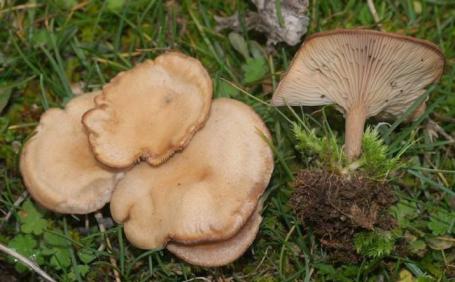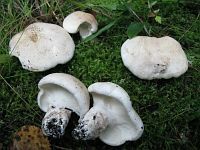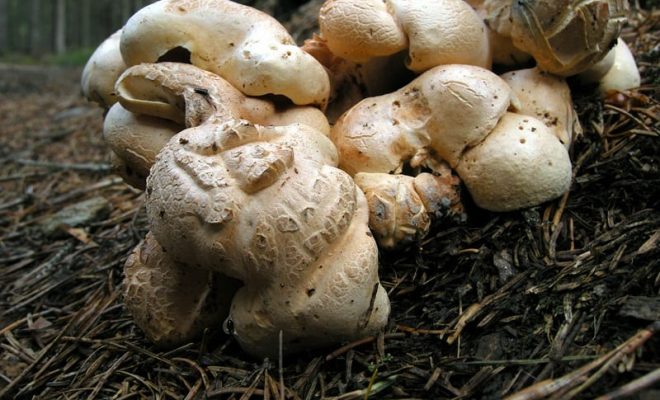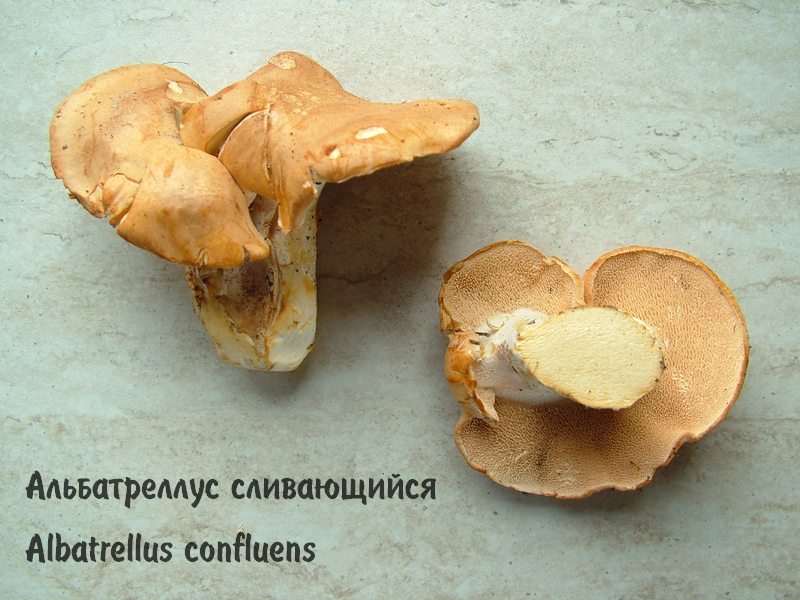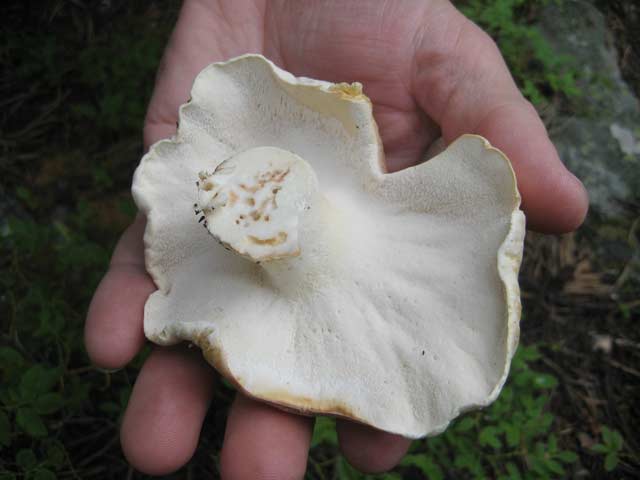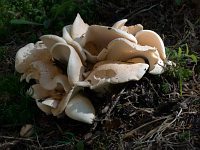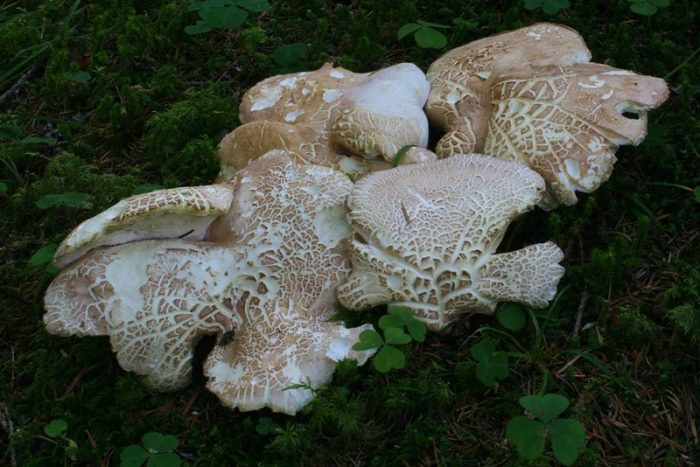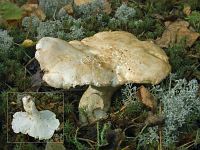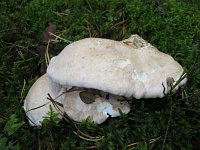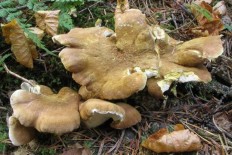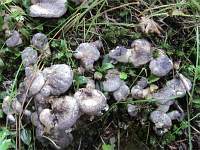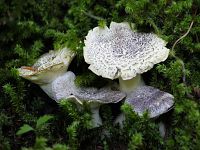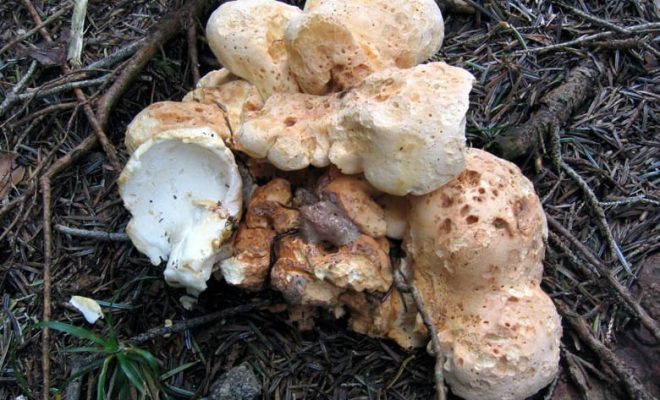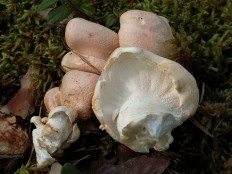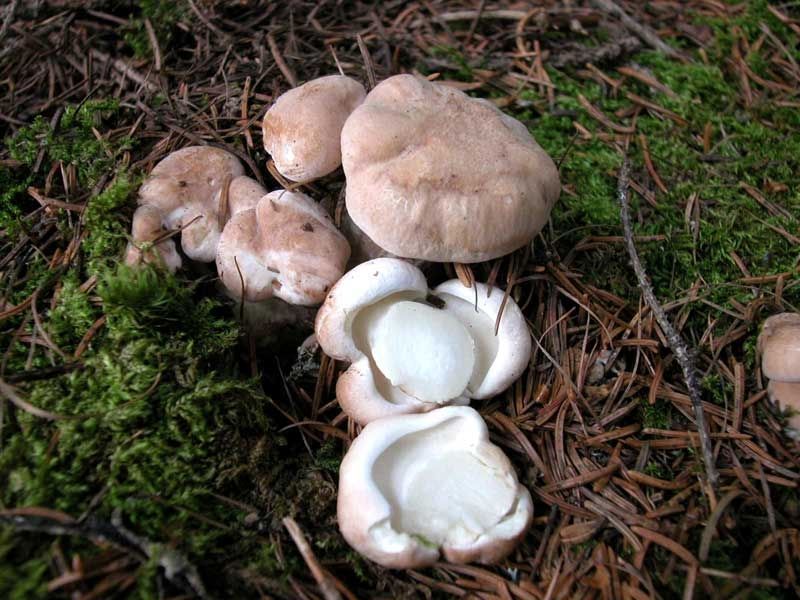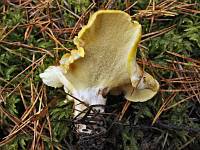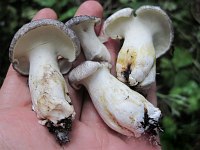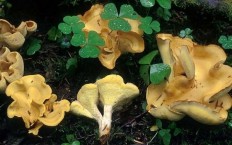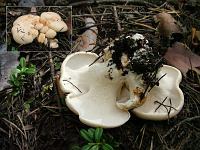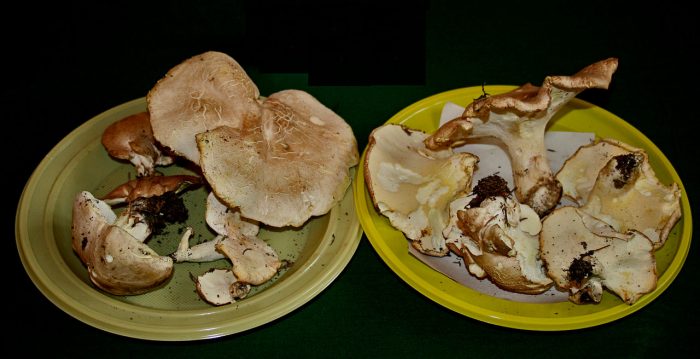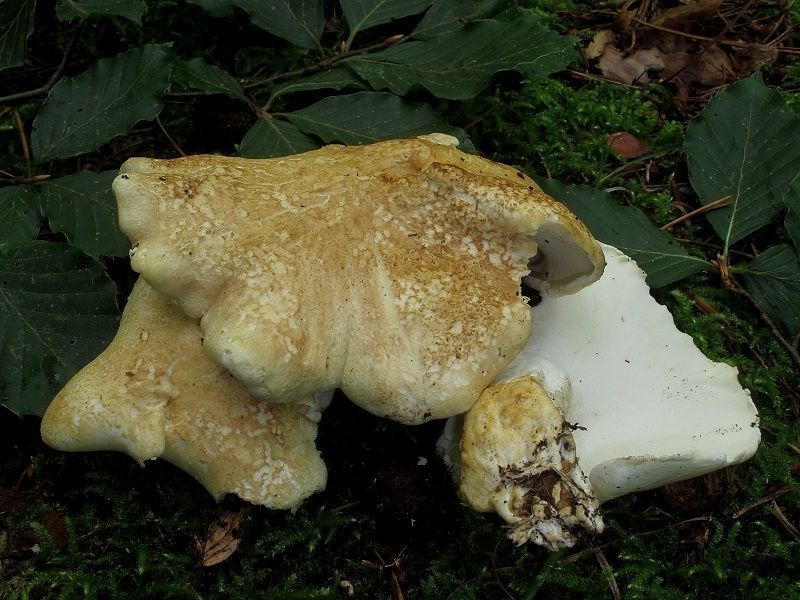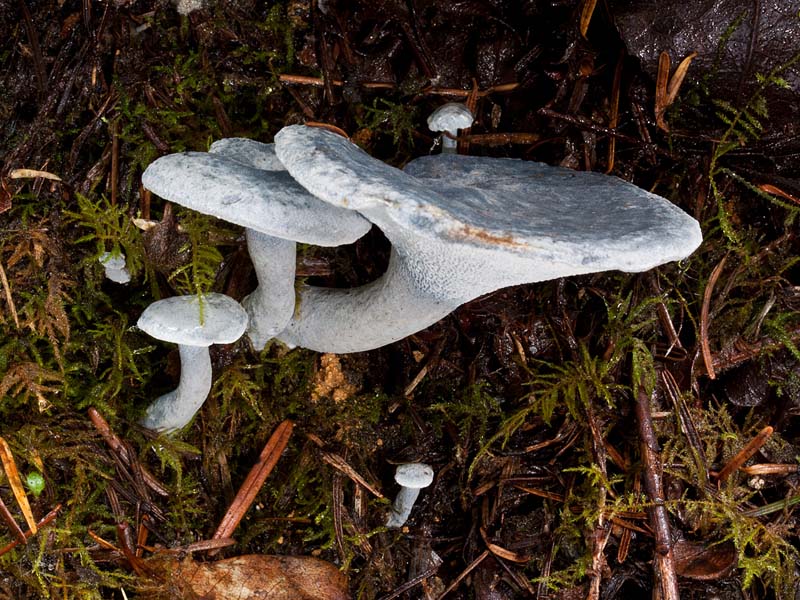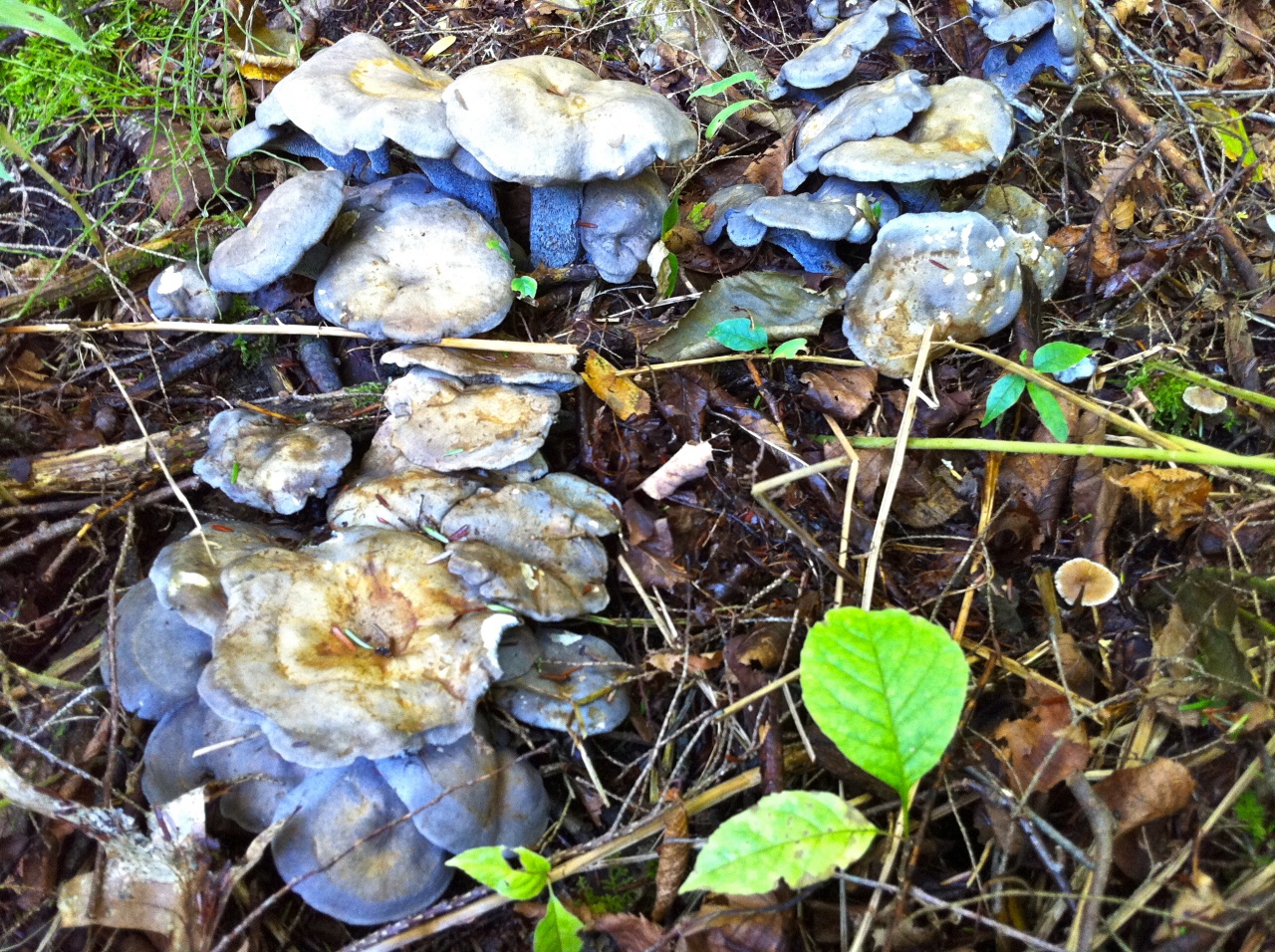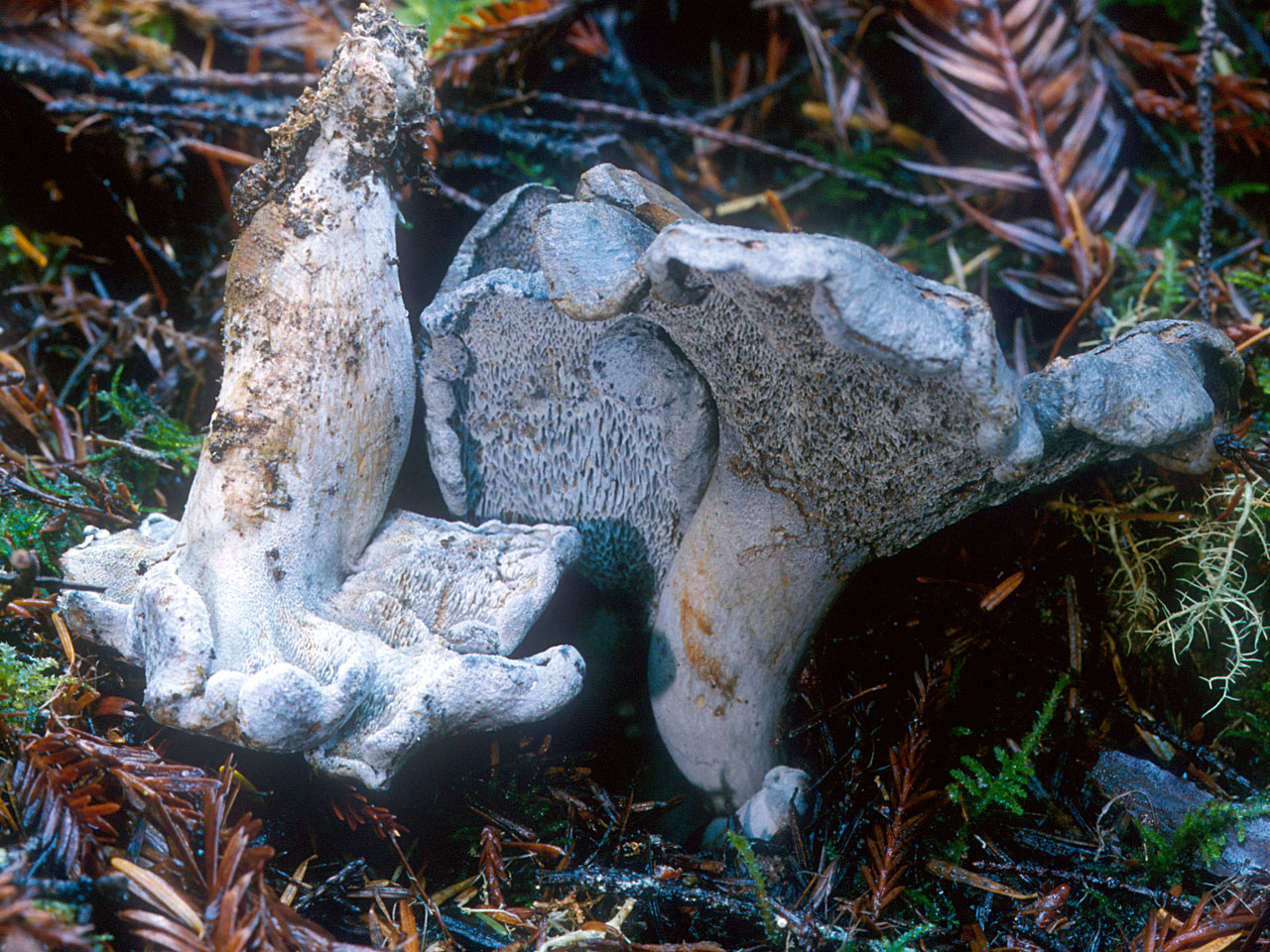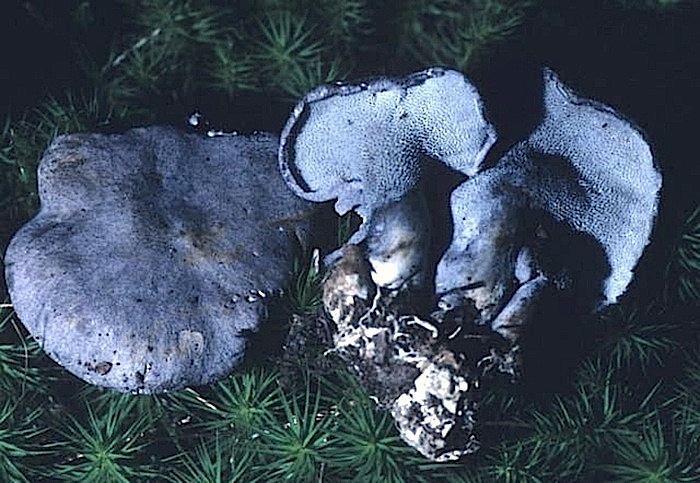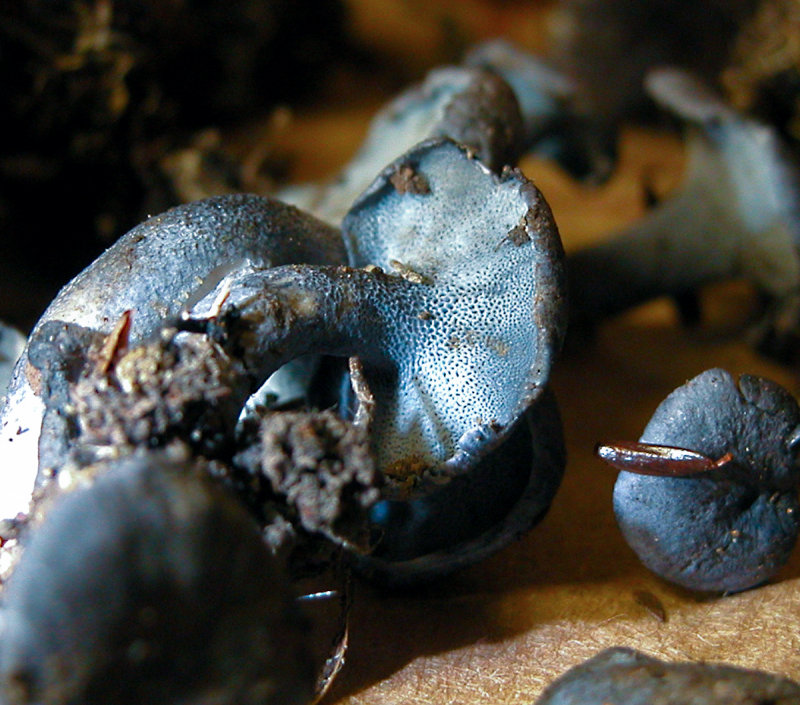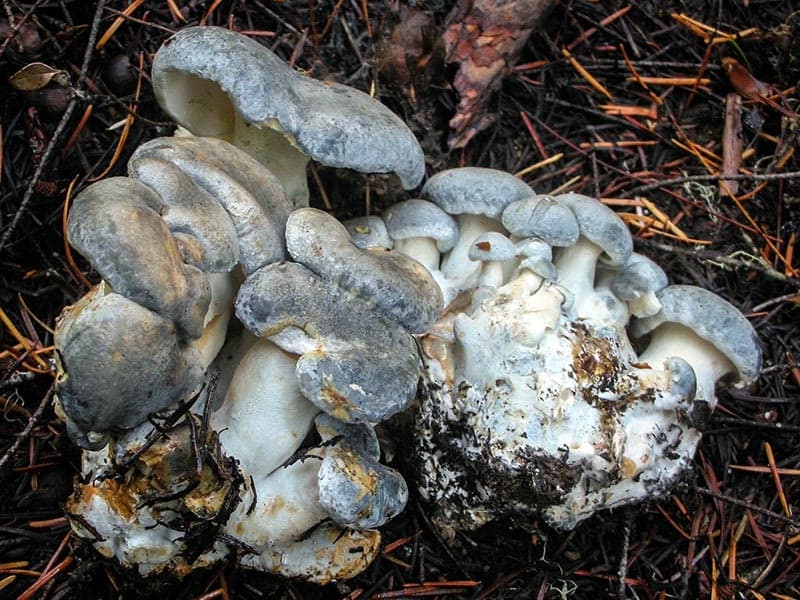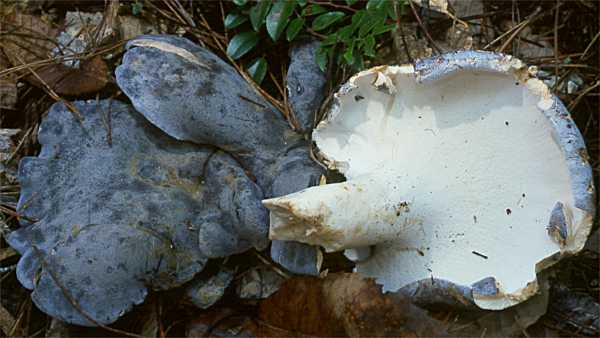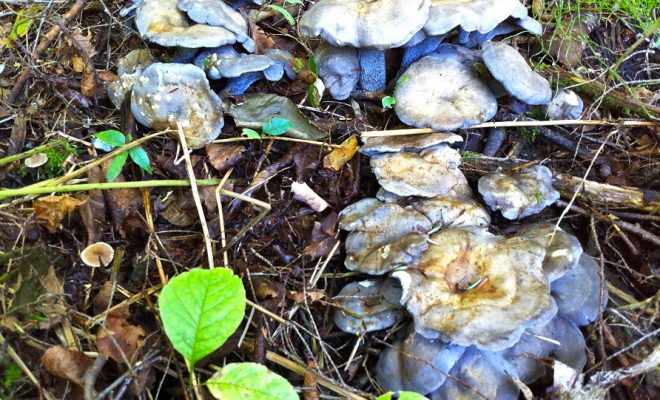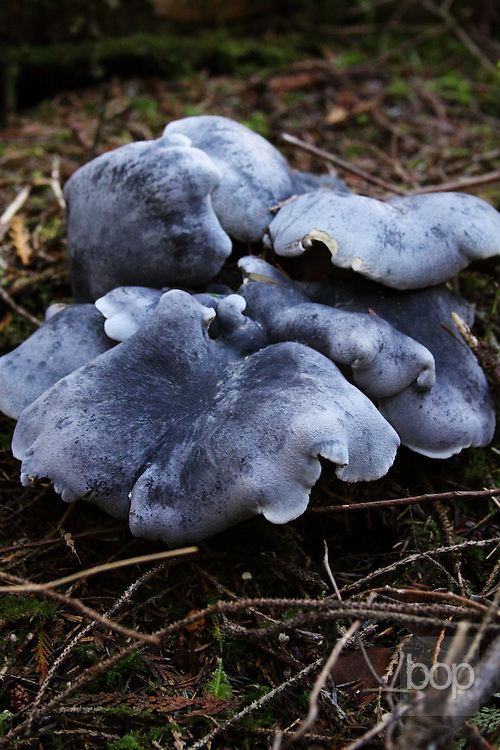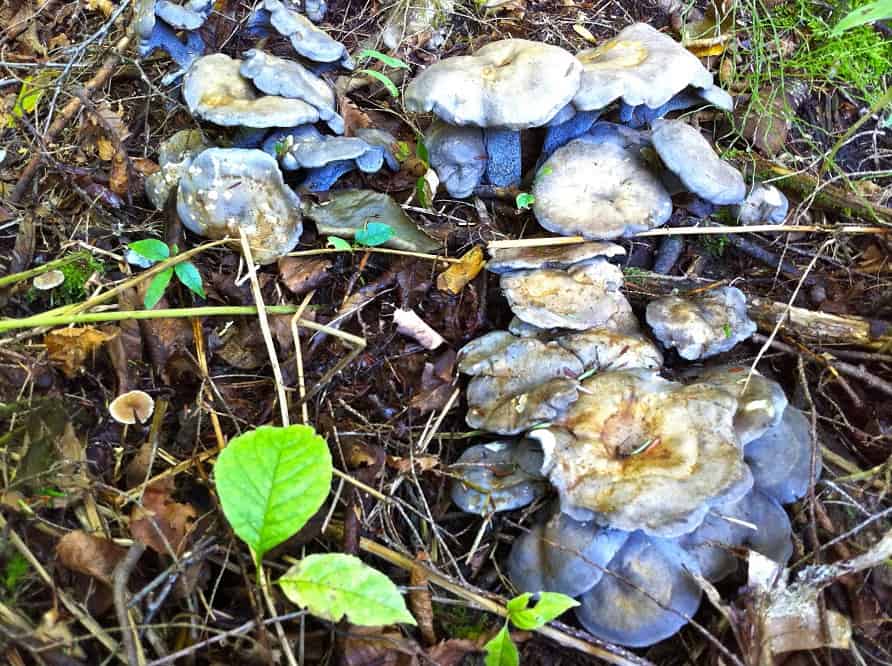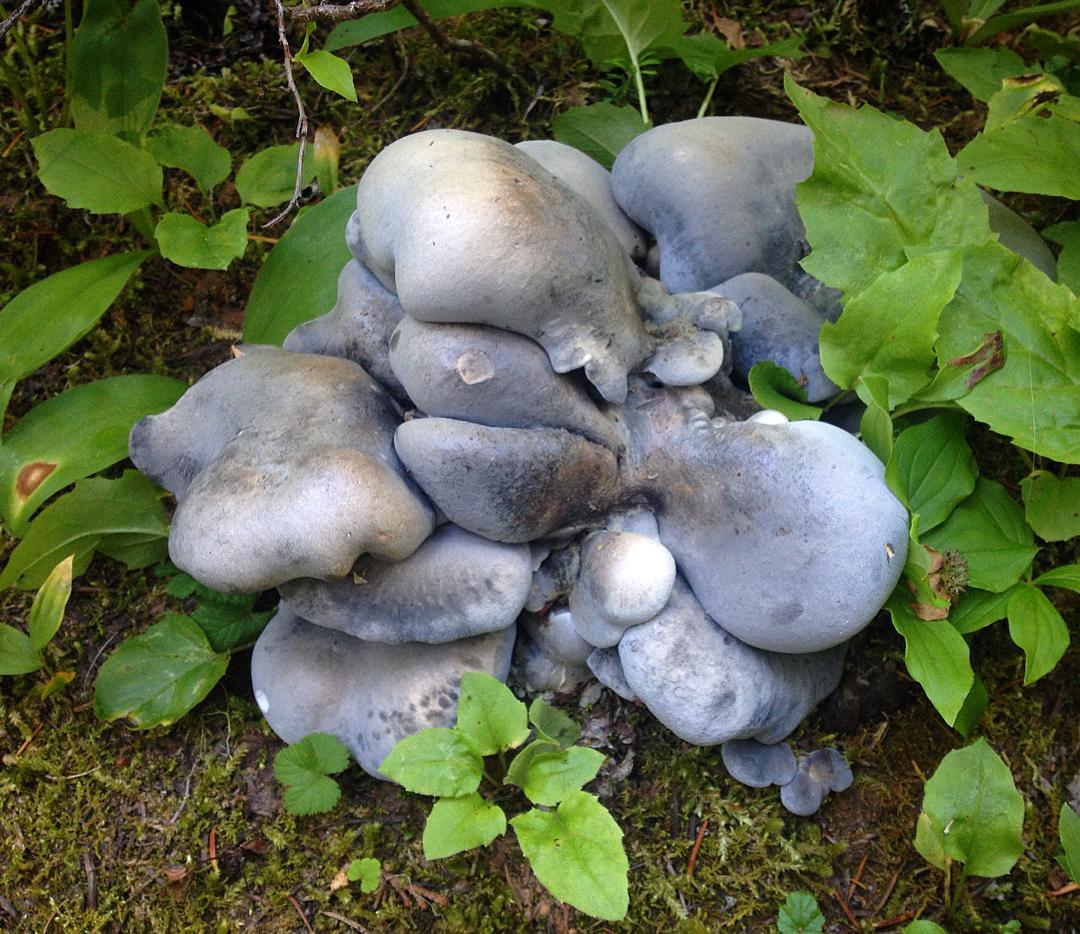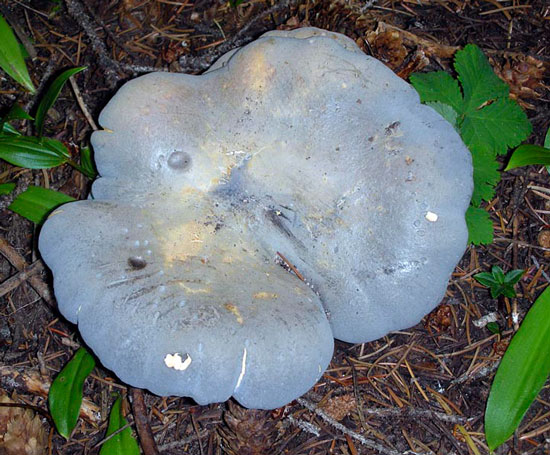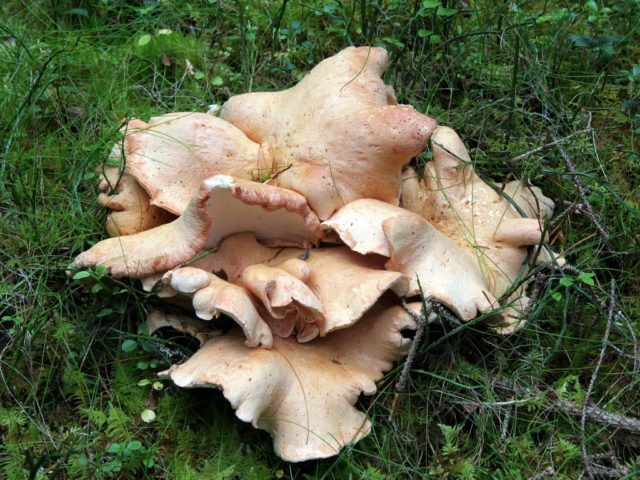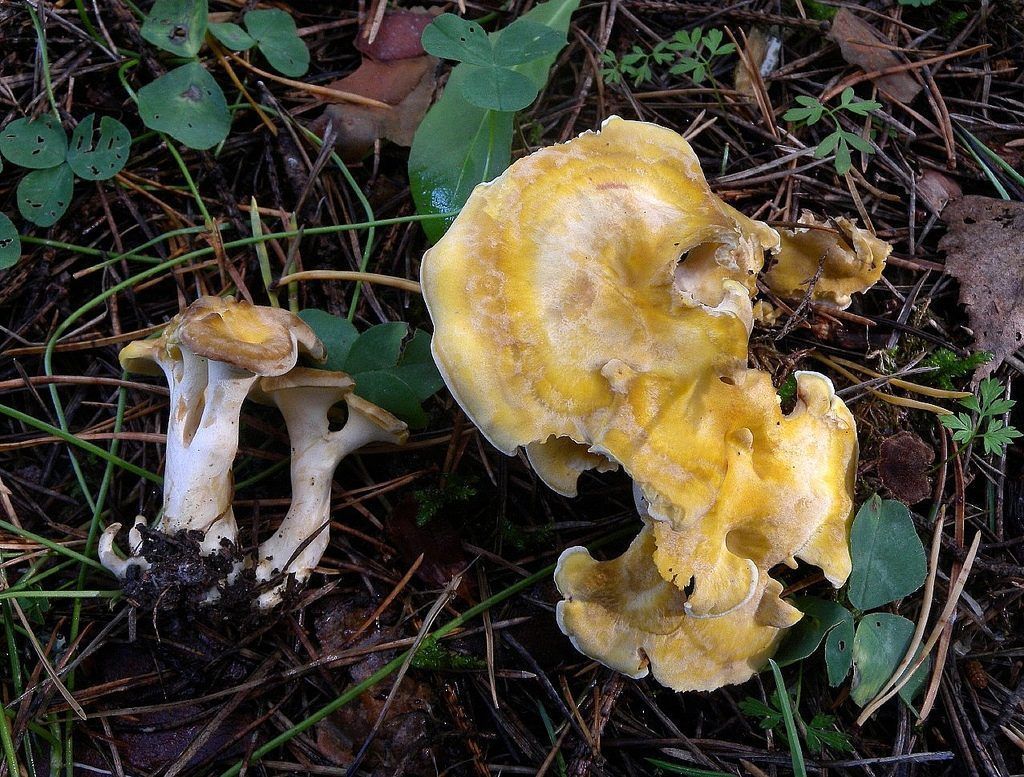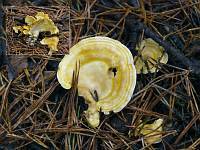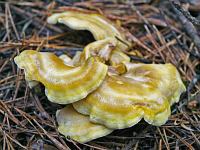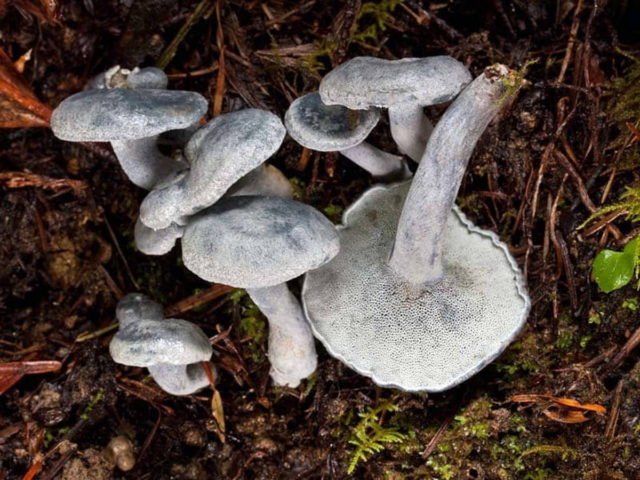Albatrellus lilac Albatrellus syringae
Syn: Scutiger syringae Parmasto, 1962 Xanthoporus syringae (Parmasto) Audet, 2010
Description by Andrey Yakimenko and Tatiana Svetlova.
Click on the marker to get additional information about the find of this species If you still know the place of growth of this species, please determine its coordinates and send them to the site
Basic information Additional Section-3
On off. mushroom find map
| Full scientific name of this species: Albatrellus syringae (Parmasto) Pouzar, 1966 |
This species belongs to tinder fungi, despite the fact that it lives on the soil and has fruiting bodies with a cap and a leg. The hats are yellow and usually have a few darker areas; legs narrowed towards the base, with mycelial cords. Fruiting bodies very often grow together with the legs and edges of the caps in several copies. It grows near the trunks and stumps of lilacs and some other hardwoods. Rare view. (Tatiana Svetlova)
Common names
FI: Keltakääpä (Finland) DE: Wiesen-Porling; Gezonter Porling (Germany) DK: Gul Fåreporesvamp (Denmark)
Sporecap fruiting body
Fruiting bodies are annual, consisting of a cap and a leg, single or accrete, 2-4 specimens. Caps 3 - 12 cm in diameter up to 1 cm thick, with a thinner, sharp wavy or lobed edge, rounded, kidney-shaped, funnel-shaped, sometimes convex in the center. The surface is glabrous or slightly pubescent, yellow-cream, ocher-yellow, clearly or indistinctly zoned, with darker zones, often egg-yellow along the edge, brownish in old age.
Hymenophore Hymenophore
Tubules descending along the stem, up to 3 mm long, thick-walled. The surface of the hymenophore is pale lemon, yellow-cream, later dirty yellow with a whitish bloom. The pores are rounded, angular, sometimes with ciliate margins, 3-4 (5) per 1 mm.
Micromorphology Micromorphology
The hyphalous system is monomytic. The hyphae of the tissue of the cap and legs are densely woven, hyaline, branching, sinuous, thin-walled, with a varying diameter from 3 to 15 microns, in swellings up to 25 microns in diameter, with small buckles. The hyphae of the tubules are parallel tightly woven, often with granular contents, 2-5 µm in diameter. Basidia are clavate, with a buckle at the base, 15–25 x 5–7 µm, with 4 sterigmas 2–4 µm in length. Spores are broadly ellipsoidal, flattened on one side, hyaline, with a large droplet, 3.5 - 5 x 2.5 - 3.5 µm.
Stem leg
The leg is densely fleshy, brittle, somewhat fibrous, often central, 1 - 7 cm long, 1 - 2 cm in diameter, tapering towards the base, with mycelial cords. The color is cream, ocher yellow. In old fruiting bodies, the stem may be hollow.
Flesh pulp
The tissue of the cap is fleshy, slightly fibrous, zoned, whitish or dark creamy with a pleasant nutty flavor; dry hard and brittle.
Habitat habitat
Grows on soil in parks, forests, near the trunks or stumps of lilac, willow, linden, alder.
Distribution of Areal
The species is common in Europe, Asia, North America. On the territory of Russia, it was noted in the European part (Moscow region), Western Siberia (Yamalo-Nenets Autonomous Okrug), Irkutsk region, in the Far East.
Calendar Calendar
It grows from spring to late autumn.
Edibility Edibility
Edible.
Remarks
The species is included in the Red Lists of the following European countries: Estonia (CR), Norway (LC). It is not listed in the Red Data Books of the constituent entities of the Russian Federation, as well as the Red Data Book of Russia. Note: in brackets is the status that characterizes the degree of rarity of the described species in a given country.
Taxon authors: Parmasto - Parmasto, Erast (1928-), Estonian botanist and mycologist - described this species as Scutiger syringae; Pouzar - Pouzar, Zdenek (1932-), Czech mycologist.
Similar species and dangerous twins
Albatrellus Merging has no poisonous counterparts. The closest similar species is the Sheep Tinder. The main difference lies in the color of the mushrooms. The surface of the sheep is yellow, and when you press on the cap, a greenish tint appears on the bends. Albatrellus blushing also belongs to related species. It has a light brown cap that, when pressed, produces pink and red spots.
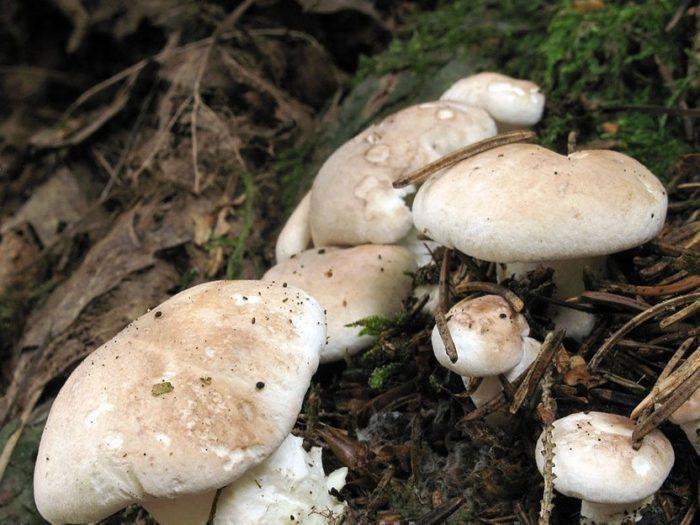 Sheep tinder
Sheep tinder
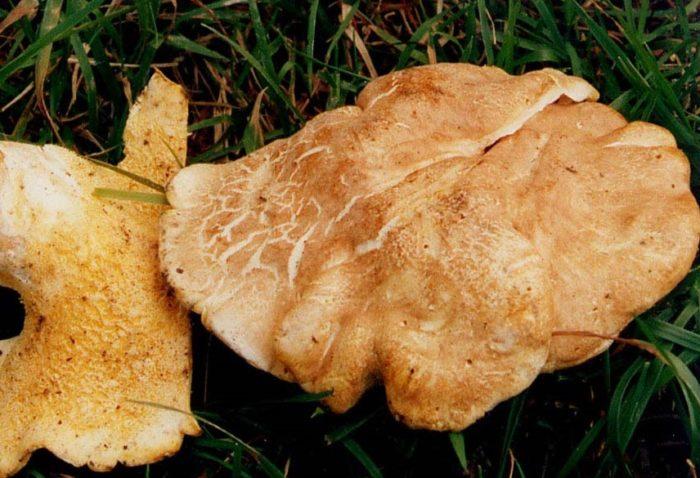 Albatrellus blushing
Albatrellus blushing
Albatrellus confluent is a non-poisonous edible mushroom that has medicinal uses. With his participation, you can prepare delicious soups, stews and fried dishes
This type of mushroom is quite rare, and growing it at home is impractical - it is better to pay attention to the cultivation of other, more tasty and nutritious "congeners"
Synonyms
- Albatrellopsis confluens (Alb. & Schwein.) Teixeira, 1993
- Boletus artemidorus Lenz, 1830
- Boletus aurantius Schaeff., 1774
- Boletus confluens Alb. & Schwein., 1805: Fr., 1821 basionym non Boletus confluens Schumach., 1803, q. e. Coltricia perennis (L.: Fr.) Murrill, 1903
- Boletus nitens J.F. Gmel., 1792
- Caloporus confluens (Alb. & Schwein.) Quél., 1888
- Caloporus politus (Fr.) Quél., 1886
- Cladomeris confluens (Alb. & Schwein.) Quél., 1886
- Merisma confluens (Alb. & Schwein.) Gillet, 1878
- Polypilus confluens (Alb. & Schwein.) P. Karst., 1881
- Polyporus artemidorus (Lenz) Fr., 1838
- Polyporus confluens (Alb. & Schwein.) Fr., 1821
- Polyporus laeticolor (Murrill) Sacc. & D. Sacc., 1905
- Polyporus pachypus Pers., 1825
- Polyporus politus Fr., 1836
- Polyporus whiteae (Murrill) Sacc. & D. Sacc., 1905
- Scutiger confluens (Alb. & Schwein.) Bondartsev & Singer, 1941
- Scutiger confluens f. politus (Fr.) Bondartsev, 1953
- Scutiger laeticolor Murrill, 1903
- Scutiger whiteae Murrill, 1903
Albatrellus ovinus (Albatrellus ovinus)
Other names:
- Scutiger ovinus
Albatrellus ovine, ovine mushroom (Albatrellus ovinus) grows in dry pine and spruce forests. Belongs to the well-known mushroom family Tinder fungus.
Description:
The round mushroom cap reaches ten centimeters in diameter. In an old mushroom, it cracks. The skin of the cap of the young mushroom is dry and silky to the touch. The lower surface of the mushroom cap is covered with a fairly dense layer of white-colored tubes, which are easily separated from the mushroom pulp. The surface of the cap is dry, naked, at first smooth, silky in appearance, then slightly scaly, cracking in old age (especially during dry periods). The edge of the cap is thin, sharp, sometimes pubescent, from slightly wavy to lobed.
Tubular layer strongly descending on the leg, the color varies from white or cream to yellow-lemon, greenish-yellow, turns yellow when pressed. The tubules are very short, 1–2 mm long, the pores are angular or rounded, 2–5 per 1 mm.
The stem is short, 3 - 7 cm long, thick (1 - 3 cm thick), strong, smooth, solid, central or eccentric, narrowed towards the base, sometimes slightly bent, from white (cream) to gray or light brown.
Spore powder is white. The spores are almost round or ovoid, transparent, smooth, amyloid, often with large drops of fat inside, 4 - 5 x 3 - 4 microns.
The pulp is dense, damp, brittle, white, yellow or yellowish-lemon when dry, often turns yellowish when pressed. The taste is pleasant, soft or slightly bitter (especially in old mushrooms). The smell is rather unpleasant, soapy, but according to some literary data, it can be both inexpressive and pleasant, almond or slightly mealy. A drop of FeSO4 stains the flesh gray, KOH stains the flesh a dirty golden yellow color.
Spreading:
Albatrellus ovine occurs infrequently from July to October on the soil under spruces in dry coniferous and mixed forests in clearings, clearings, forest edges, along roads, and also in the mountains. Prefers neutral and alkaline soils, often grows in moss. Forms clusters and groups with closely adhered to each other, sometimes growing together, legs and edges of caps, fruit bodies. Single specimens are less common. The species is widespread in the northern temperate zone: it is recorded in Europe, Asia, North America, and also found in Australia. On the territory of Russia: in the European part, Siberia and the Far East. Moss cover is considered a favorite place for growth. Tinder fungus is a rather large mushroom. It grows singly or in groups, sometimes growing together with its legs.
Similarity:
Ovine albatrellus in its appearance is similar to the confluent tinder fungus, which has a more brown color. Yellow blackberry (Hydnum repandum) is distinguished by a hymenophore, consisting of thick light creamy spines slightly descending on the leg. Albatrellus confluens is colored orange or yellow. brown tones, with a bitter or sour taste. It has accrete, usually uncracking caps, grows under various conifers. Albatrellus subrubescens is colored orange, light ocher or light brown, sometimes with a purple tint. The tubular layer is light orange.Grows under pine and spruce trees, has a bitter taste. Albatrellus cristatus has a brown-green or olive cap, grows in deciduous forests, most often in beech groves. Lilac albatrellus (Albatrellus syringae) is found in mixed forests, colored in golden yellow or yellowish brown tones. The hymenophore does not descend on the leg, the pulp is light yellow.
Grade:
Albatrellus ovine is a little-known edible mushroom of the fourth category. The mushroom is suitable for consumption only in an unripe form. Young caps of this mushroom are used fried and boiled, as well as stewed. Before use, the mushroom must be boiled with the preliminary removal of the lower part of its leg. In the process of boiling, the mushroom pulp acquires a yellowish-green color. The mushroom is considered especially tasty when fried raw without preliminary boiling and heat treatment. Ovine albatrellus can be pickled with spices for long-term storage.
The species is listed in the Red Book of the Moscow Region (category 3, a rare species).
Used in medicine: scutigeral, isolated from the fruiting bodies of ovine tinder fungus, has an affinity for dopamine D1 receptors in the brain and may act as an oral pain reliever.
How to cook?
There are many ways to prepare albatrellus ovinus for human consumption. Dried tinder fungi are especially appreciated, since in this form they retain their taste as much as possible. In addition, they are pickled, used for making soups and main courses, and salads are made.
How to dry a mushroom?
Polypores can be harvested for the winter by drying. To do this, fresh mushrooms are cleaned, wiped with a towel and strung on a thread. If weather permits, you can dry outdoors, but you need to constantly monitor this process. Tinder fungus quickly absorbs moisture, so any light rain or fog will backfire. A tinder fungus that has collected water will quickly grow moldy and deteriorate.
If the weather is humid, you can dry the mushrooms in an oven or oven. Do not overdry: a specimen that is too dry will lose its taste. If the sheep tinder fungus is dried correctly, it will smell and taste like a fresh mushroom. The finished product should be stored in sealed glass containers, where moisture does not get.
How to pickle?
A good way to preserve tinder fungus is to pickle it. This will require a glass or enamel container. You can use a wooden tub. Mushrooms need to be sorted out, peeled and boiled in salted water for 30 minutes. Then transfer to a prepared container and add 50 g of salt per 1 kg of mushrooms.
To taste, you can put a few cloves of garlic, bay leaves, black and allspice. Mix everything and put under oppression. The mushrooms will be ready in a week. Sheep tinder fungus can be stored for a long time in a cool room. The marinade must completely cover the mushrooms so that they do not spoil.
Best soup recipe
A delicious soup is made from sheep's mushroom according to the following cooking recipe:
- fresh mushrooms - 1 kg;
- onions - 4 pcs.;
- any cereal - 350 g;
- vegetable oil;
- greens;
- seasonings to taste.
The tinder fungus is cleaned, the legs are removed, and cut into small pieces of the same size. Then it is poured over with water and boiled for 15 minutes. At this time, you need to chop the onion and fry it in vegetable oil. Fried onions, cereals, herbs and seasoning are added to a saucepan with mushrooms, and then boiled for about 5 minutes until cooked.
Second courses and salads
Sheep tinder fungus is well suited for preparing salads. You can use it both fresh and pickled. Finely chopped mushrooms are mixed with boiled potatoes and green peas, pickled cucumbers or pickled cabbage are added if desired. You can fill the salad with sour cream, mayonnaise or sunflower oil.
Mushroom rolls can be prepared as a second course.
- To do this, tinder fungi need to be fried, chopped, add onions and spices.
- Put finely chopped boiled eggs in the mushroom mince, cheese and mayonnaise if desired.
- Wrap the minced meat in lavash slices and serve beautifully, decorating with herbs.
Dishes from sheep's tinder fungus will not go unnoticed during a large feast.
Albatrellus cristate (Laeticutis cristata)
Synonyms:
Albatrellus cristatus
Photo Credit: Zygmunt Augustowski
Basidiomas in this fungus are annual. Sometimes they are solitary, but it is much more common that they grow together at the base, and the edges of the caps remain free.
Faced with Albatrellus comb, you can see a hat with a diameter of 2-12 cm and a thickness of 3-15 mm. The shape is round, semi-round and kidney-shaped. Often mushrooms are irregular in shape and depressed towards the center. In old age and with dryness, they become very brittle.
The top is thinly pubescent. Later, it begins to become more and more rough, breaks and scales at the center become visible. The surface of the cap has an olive-brown, yellowish-green, less often red-brown bloom, with a greenish tint at the edges.
The edge itself is very flat and coarse. The fabric of this representative of Albatrell is white, but towards the middle it becomes noticeably yellow, even lemon. Differs in fragility and fragility. The smell is slightly sour, the taste is not particularly pungent. Thickness up to 1 cm.
The tubes of this mushroom are rather short. only 1-5 mm in length. They are downhill and white. Like all mushroom breeds, they change their color when dried. It takes on a yellow, dirty yellow or red hue.
Pores tend to enlarge with age. Initially, they are small in size and round in shape. Placed with a density of 2-4 by 1mm. Over time, they not only increase in size, but also change shape, look more angular. The edges become scored.
The stem is central, eccentric, or nearly lateral. It has a white color, often set off by marble, lemon, yellow or olive colors. Leg length up to 10 cm and thickness up to 2 cm.
Albatrellus comb has a monomytic hyphal system. The tissues are wide with thin walls, the diameter varies (the diameter ranges from 5 to 10 microns). No buckles. The hyphae of the tubules are located rather consistently, have thin walls and are branched.
Basidia are club-shaped, and spores are elliptical, spherical, smooth, hyaline. They have thickened walls and are drawn obliquely near the base.
Found in deciduous and mixed forests, where there are oaks and beeches. Germinate on a sandy soil surface. Often found on roads that are overgrown with grass.
The geographical location of Albatrellus crested is Russia (Krasnodar, Moscow, Siberia), Europe, East Asia and North America.
Eating: Not edible mushroom, because it is tough enough and has an unpleasant taste.
Description of the sheep tinder
Sheep tinder fungus, also called sheep albatrellus, is a mushroom with a dense, brittle white flesh that turns yellow when dried or lightly pressed. It smells most often not very pleasant, soapy, but some argue that the smell can be flour or almond.

It is easy to recognize a sheep tinder fungus by its characteristic structure
The easiest way to recognize fruiting bodies is by the structure of the cap and stem. Therefore, the photo and description of the sheep tinder fungus should be studied more carefully.
Description of the hat
Sheep tinder fungus is a medium-sized mushroom, the cap of which can reach 10 cm in diameter. In shape, it is most often rounded, but the edges can be wavy or lobed, sharp and thin. In the photo of the sheep tinder fungus, it is noticeable that in mature fruiting bodies, the caps often crack, and in young ones they are even, silky to the touch and covered with a smooth skin. The color of the mushroom ranges from whitish to beige and cream.
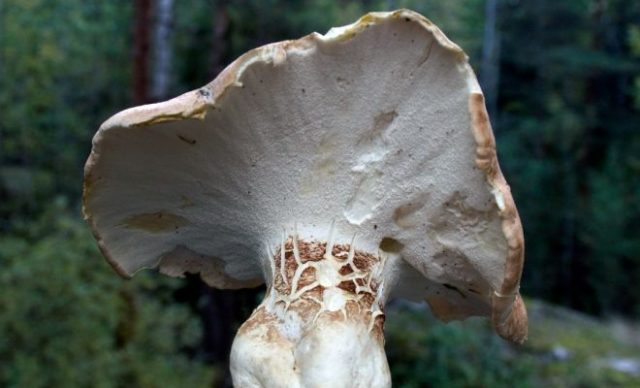
Albatrellus sheep's hat is wavy, with a thin sharp edge
The lower surface of the cap of the sheep tinder fungus is tubular, running strongly down the leg. The color of the tubules is also white, cream, greenish-yellow or yellow-lemon, noticeably yellow when pressed. The pores of the tinder fungus are rounded or angular in shape.
Leg description
The ovine albatrellus mushroom rises on average 3-7 cm above the ground, the girth of the leg is up to 3 cm.In structure, the leg is dense and smooth, solid from the inside, in shape - straight or slightly curved, with a slight narrowing towards the base. A photo of a sheep mushroom demonstrates that the color of the leg is the same as that of the rest of the mushroom, white, cream, beige or grayish.

Description
Fruiting bodies are cap-stalk, annual, often in the form of several caps on a branched stalk. Caps are from rounded to fan-shaped or irregularly lobed, up to 11 cm in greatest dimension and up to 3 cm thick, the upper surface is pinkish-beige, salmon-pink when dry, often cracking into separate areas with age.
The hymenophore is tubular, cream-colored, when it dries, it becomes salmon pink. Pores from rounded to angular, 3-5 per millimeter, with thick septa.
The stem is central to lateral, cream or pinkish-beige, naked, when dry salmon-pink, wrinkled, up to 8.5 cm long.
The pulp is soft and fleshy, creamy, when dry it is pinkish-yellowish-brown, when it dries, it is tough, resinous, often with a pleasant smell, with a peculiar cabbage taste and a bitter aftertaste.
The hyphalous system is monomytic. Cystyds are absent. Basidia are tetrasporous, clavate, 20–30 × 6–7.5 µm. Spores ovoid or elliptical, uncolored, 4-5 × 2.5-3.5 µm.
Cooking recommendations
Delicious soups are made from dried mushrooms. Fruit bodies can even be eaten raw. They make delicious fried, stewed and first courses.
How to clean
Albatrellus merging does not need cleaning. If you need to free the pulp of the mushroom from the top skin, you can scrape it off with a knife.
How to dry
Tinder fungus is suitable for harvesting for the winter. Mushrooms are washed, peeled and strung on a thread. In good weather they can be dried outside, but they tend to absorb moisture, so the drying process must be controlled. If the mushrooms are saturated with water, they can become moldy and unusable.
In bad weather, albatrellus can be dried in the oven or oven. But you need to try not to overdry, otherwise they may lose their taste. Store the finished product in a dark place, in hermetically sealed glass jars.
How to pickle
Glass or enamel containers are suitable for pickling. The procurement process is simple:
- The mushrooms should be peeled, transferred to a saucepan and boiled for 30 minutes.
- Add salt to the broth (for 1 kg of fruit bodies, 50 g of salt will be required).
- Add bay leaves, garlic and allspice to taste.
- Mix well and put under oppression.
After 7-10 days, the tinder fungus will be ready to eat. Store in a cool place.
Soup recipe
To prepare the first course, you will need the following ingredients:
- mushrooms - 1 kg;
- onion - 2 medium heads;
- carrots - 1-2 pcs.;
- groats (buckwheat, rice, millet) - 300-350 g;
- vegetable oil;
- greens.
Step by step cooking
- Before cooking, you need to wash the tinder fungus, remove the legs and cut into pieces.
- You need to cook the broth for at least twenty minutes, after which you should add fried onions, grated carrots and cereals to it.
- Add herbs and seasonings if desired.
- The soup should be boiled for 10-15 minutes.
Meaning of albatrellus confluent
Albatrellus confluent is an edible mushroom, but with a specific bitter taste. In Europe, albatrellus are collected relatively rarely, but in North America they are valued much higher. These mushrooms are considered to be of good quality with a peculiar consistency.
The usefulness of fusing albatrellus
In Japan, in 1948, it was discovered that the composition of fusion albatrellus contains grypholin, which has antibiotic activity. In experiments carried out on rats, it was found that this substance, in addition, reduces the level of cholesterol in the blood. In 1992, polysaccharides with antitumor properties were found in fruiting bodies.

Other mushrooms of this genus
Albatrellus Tien Shan or Scutiger Tien Shan is a solitary, annual mushroom. Young mushrooms have elastic and fleshy caps.
The diameter of the cap is 2-10 centimeters, and the thickness reaches 0.5 centimeters. With a small amount of moisture, the caps become thin and brittle. In the central part, the cap is depressed. The cap is covered with radial-concentric scales, its color is dirty yellow. The leg is 2.5-4 centimeters long and 0.7 centimeters in diameter. At the bottom, it is slightly swollen. The leg has almost no color.
Tien Shan albatrellus can be found in spruce forests. These mushrooms love to hide in the grass. They grow in Kyrgyzstan, Tien Shan, at an altitude of 2200 meters. Young specimens are edible, while old ones are very tough.
Albatrellus lilac can grow on both soil and wood, and it prefers deciduous trees. This species is common in Europe, Asia and North America. It is very rare in our country, in the Leningrad region and central regions. These mushrooms grow in forests and parks. They bear fruit from spring to autumn.
The diameter of the lilac albatrellus cap is 10-12 centimeters. The central part is convex, and the edge is lobed. At a young age, the shape of the cap resembles a funnel, and over time it becomes flat-convex. The color of the cap is egg-cream, yellow, sometimes there may be dark spots. If mushrooms grow on the ground, then the length of the legs reaches 5-6 centimeters, and in specimens growing on trees, the legs are very short. The color of the leg is in the color of the cap. Albatrellus lilacs belong to the edible category of mushrooms.

Albatrellus confluent is an edible mushroom with a specific bitter taste.
Synonyms
- Albatrellopsis confluens (Alb. & Schwein.) Teixeira, 1993
- Boletus artemidorus Lenz, 1830
- Boletus aurantius Schaeff., 1774
- Boletus confluens Alb. & Schwein., 1805: Fr., 1821 basionym non Boletus confluens Schumach., 1803, q. e. Coltricia perennis (L.: Fr.) Murrill, 1903
- Boletus nitens J.F. Gmel., 1792
- Caloporus confluens (Alb. & Schwein.) Quél., 1888
- Caloporus politus (Fr.) Quél., 1886
- Cladomeris confluens (Alb. & Schwein.) Quél., 1886
- Merisma confluens (Alb. & Schwein.) Gillet, 1878
- Polypilus confluens (Alb. & Schwein.) P. Karst., 1881
- Polyporus artemidorus (Lenz) Fr., 1838
- Polyporus confluens (Alb. & Schwein.) Fr., 1821
- Polyporus laeticolor (Murrill) Sacc. & D. Sacc., 1905
- Polyporus pachypus Pers., 1825
- Polyporus politus Fr., 1836
- Polyporus whiteae (Murrill) Sacc. & D. Sacc., 1905
- Scutiger confluens (Alb. & Schwein.) Bondartsev & Singer, 1941
- Scutiger confluens f. politus (Fr.) Bondartsev, 1953
- Scutiger laeticolor Murrill, 1903
- Scutiger whiteae Murrill, 1903


